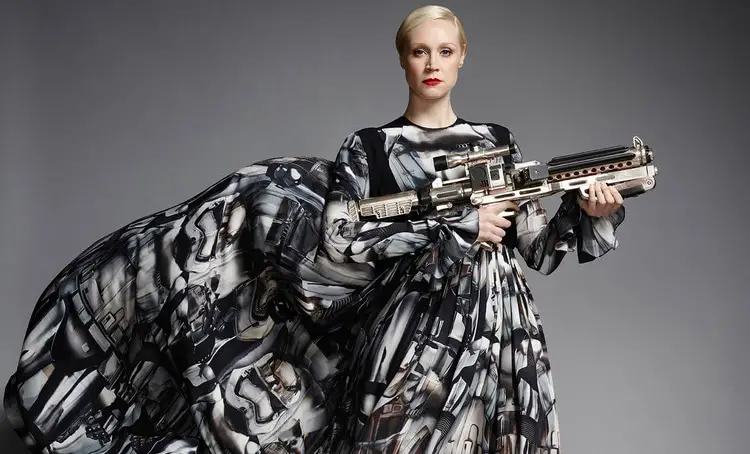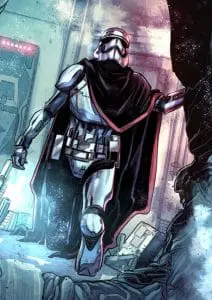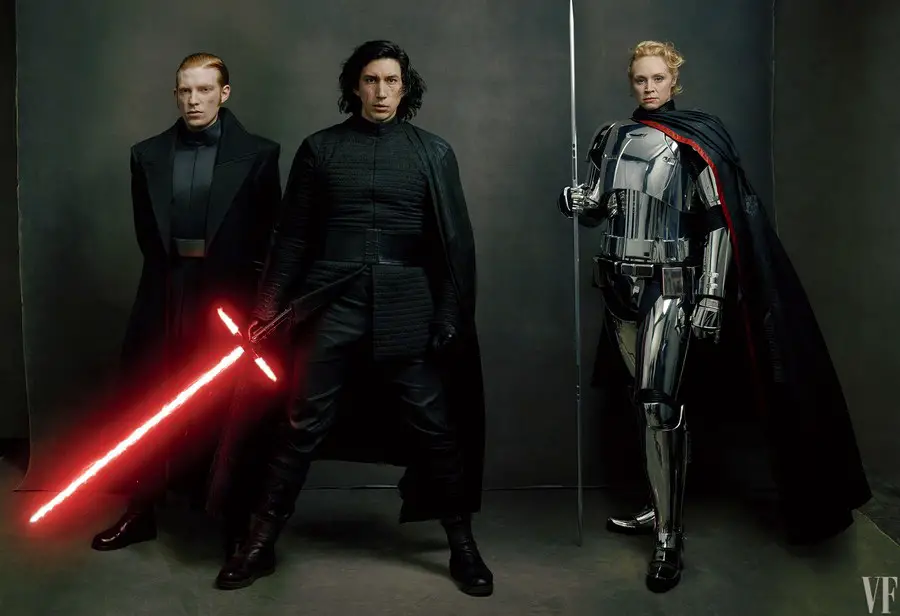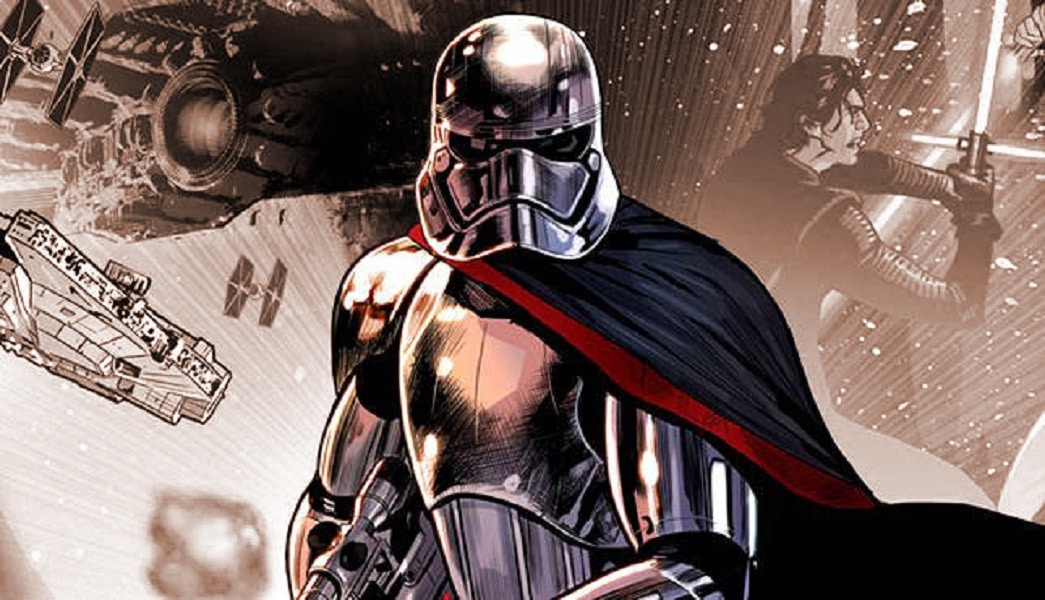[dropcap]O[/dropcap]n the edge of a cliff, a young woman stares into the vast unknown. Nothingness seems to cascade over the valleys as far as the human eye can see. Yet, there is one who is unafraid of the unknown landscape… Phasma. She stares into the unknown with confidence, determination, and a strong will to survive. On the degrading hostile planet of Parnassos, Phasma’s ambition, wit, and instinct mesh into one unique body.

America writer, Delilah S. Dawson (author of Phasma), takes a minor female character from Star Wars VII: The Force Awakens and reveals her to be a legend. Although her appearance in The Force Awakens was brief, it was powerful! Phasma remains a legend within the franchise today and many fans (like me!) are waiting to see how the franchise uses Phasma in their upcoming film The Last Jedi (releasing December 15th, 2017). However, Phasma accomplishes more than just making a thrilling story.
Phasma and Star Wars Episode VII
In the early stages of developing her chrome armor and flowing red cape, Captain Phasma was merely an idea. The idea was to have a powerful, independent, driven character who strikes fear in the hearts of her colleagues, subordinates, and enemies. On screen, Phasma’s impact has been incredible. Appearing in The Force Awakens for less than five minutes, her personality struck a chord in Star Wars fans everywhere.
Phasma… She represents the evolution of the beloved Star Wars culture.
Phasma’s physique, appearance, and dialogue capture her unwavering ruthlessness. However, the well-executed performance of her minor role was not the only impact Phasma’s character has had on the franchise. After the debut of The Force Awakens, Phasma’s popularity was unexpected; despite her short runtime, her popularity soared. According to one report, Phasma’s action figure was the most widely sold of all the female characters from The Force Awakens.
Phasma’s success however, may not have been the same if they hadn’t altered the character’s gender. Originally, Phasma was designed to be male and it wasn’t altered until the last minute before the production began. On the surface, the decision to change Phasma’s gender from male to female may appear minuscule, but the way it’s resonated with viewers has been great.

Phasma’s Gender
Matching Phasma’s performance with the writings of Dawson, her gender becomes highly important. Within Phasma, we witness her evolution into a female warrior, a female leader. Left to survive on the harsh surface of Parnassos, Phasma had no choice but to cast aside gender stereotypes and transform herself into their clan’s protector, their best warrior – traditionally a role given only to men. Her tale of surviving harsh environments and coming out a warrior is a tale we’ve heard many times, but almost exclusively from a male perspective.
If kept male, the character wouldn’t be nearly as unique and the way in which Dawson utilizes her gender not only adds diversity to a traditional coming of age story but adds rare depth to her character as well.
Phasma’s Appearance
 Phasma’s appearance reveals a lot about her character. If she were kept male audiences may not think twice about how the body is covered in practical armor. Typically, men in this warrior role would stay dressed, ready for combat (they too may not even reveal their face).
Phasma’s appearance reveals a lot about her character. If she were kept male audiences may not think twice about how the body is covered in practical armor. Typically, men in this warrior role would stay dressed, ready for combat (they too may not even reveal their face).
Yet, when a female (Captain Phasma) chooses to remain masked it becomes absolutely mind-boggling to audiences. By allowing Phasma to remain masked, audiences are focused more on her personality and less on her physical attractiveness. Overall, the franchise’s treatment of Phasma is refreshing. By leaving her physique a mystery, audiences are more inclined to focus on her as an individual and less as a sexualized object.
However, I don’t believe keeping Phasma’s physique hidden is the only purpose her armor serves. It also serves to expand her personality. By doing this, Phasma achieves a level of secrecy between herself and others, allowing no one inside her mind. This level of secrecy gives Phasma an edge over others. For instance, by constantly wearing her armor she refuses to show signs of weakness. This image of strength hinders conventional damsel in distress or female=weak stereotypes. Phasma demonstrates a powerful image of strength, confidence, and empowerment. An image that wouldn’t have been as impactful if the character were male.
WOMEN IN STAR WARS: The Original Trilogy
The franchise’s inclusion, treatment, and visual representation of women, stemming from the original trilogy to today, is empowering and positive for Star Wars fans everywhere.
 In regards to female characters appearing in the original trilogy, the strongest (and almost only) is Princess Leia. Early on in the original trilogy, Leia (much like Phasma) was known for her resilience, determination, and leadership. Across the first two films, Leia was never exploited or sexualized by her costumes. However, despite her strength, independence, and guidance she still fell victim to the male gaze effect.
In regards to female characters appearing in the original trilogy, the strongest (and almost only) is Princess Leia. Early on in the original trilogy, Leia (much like Phasma) was known for her resilience, determination, and leadership. Across the first two films, Leia was never exploited or sexualized by her costumes. However, despite her strength, independence, and guidance she still fell victim to the male gaze effect.
In Return of the Jedi Leia (although playing a slave) was unnecessarily sexualized by her costume. This sexualization of Leia added nothing to her character; though it did peak the interest of many male viewers. The objectification of Leia took away from all of the aspects that made-up her powerful, positive entity.
WOMEN IN STAR WARS: Today
By The Force Awakens, the Star Wars franchise chose to incorporate female characters into the main plot in positive ways. For instance, Phasma has yet to be sexualized on screen. If anything, it is her costume, gender, and rank in the First Order that contributes to not only to the expansion of her character but to how fans receive her in the universe. To create a female villain this powerful and ruthless took delicate crafting.
Left to survive on the harsh surface of Parnassos, Phasma had no choice but to cast aside gender stereotypes and transform herself.
Yet, since The Force Awakens, Dawson’s 2017 novel breathes life into this minor character. Dawson cleverly takes elements from Phasma’s appearance in the film (her costume, gender, quietness, determination, etc.) and incorporates them in ways that explain her beginnings. Dawson’s Phasma gives fans the opportunity to understand Phasma’s origins so that they may better understand her motives in The Last Jedi.

Phasma and the First Order
Normally, (throughout the original trilogy), there has never been a female villain in power. Typically, Star Wars villains throughout the Empire were all male (Darth Vader, Emperor Palpatine, Boba Fett, and Jabba the Hutt… just to name a few classic Star Wars villains).
However, the inclusion of Captain Phasma as a powerful villain in the First Order shows a positive evolution occurring within the franchise as well as within their military ranks. By altering Phasma’s gender, the Star Wars franchise has created a female villain that fans have been waiting for! As far as we have seen, she is the only high-ranking female among the First Order. Therefore, by proving herself among the Order and achieving the title of Captain, Phasma has demonstrated her strength, drive, and ingenuity.
Dawson’s novel explores how Phasma’s rank and gender operate in tandem to evolve the environment of the Order. By unlocking Phasma’s origin story and looking at her character through the perspective of a male colleague, Dawson’s Phasma demonstrates the logic, drive, and personality which leads Phasma to succeed in the First Order. However, as Dawson explores deeper into Phasma’s origins it leaves us to question her loyalty.
As audiences saw in The Force Awakens, Phasma’s strength appears to coincide with the ideals and actions of the Order. However, according to Dawson’s novel, Phasma’s past and present is the evidence we need to determine where her true loyalties lie. Are her loyalties with the First Order or to herself? The success of the Order may rely on Phasma’s personal motives. Therefore, exploring her past is the key to understanding her potential impact in the Star Wars universe.
Future of Star Wars
Though the franchise’s development of Phasma is unknown we can still speculate. The development of her character has jumped from film to novel to graphic comics. As of today, her potential within the franchise is as unknown to fans as her thoughts. With The Last Jedi quickly approaching, audiences are hoping to see more Captain Phasma! From her appearance in The Force Awakens to her expansion in Dawson’s Phasma, the character has developed tremendously.
Exploring her past is the key to understanding her potential impact in the Star Wars universe.
As The Last Jedi is released later this week, I expect to see Phasma’s character develop little by little throughout the film. Based on Dawson’s novel I expect that her actions will speak louder than her words and I hope to see her vulnerability tested, her loyalties questioned, and her true motives slowly unfold before our eyes. By utilizing and expanding Phasma, the Star Wars culture is evolving into something innovative and refreshing! We can only hope that her previous impact on the culture will be utilized even more December 15th, 2017.
Which new character do you think is shaking up the Star Wars culture? Share your thoughts in the comments below!





